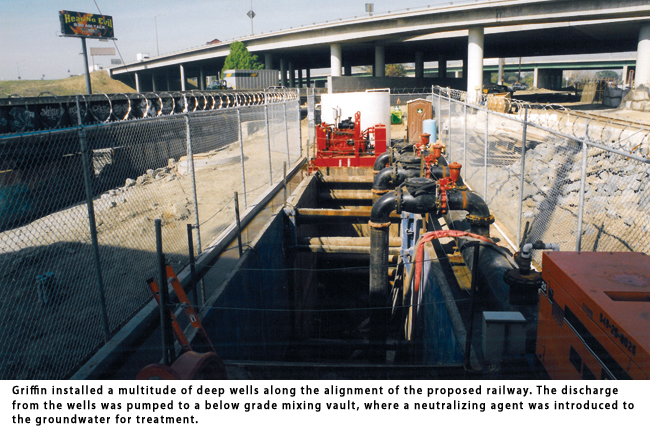Mud on the Tracks
The Alameda Corridor is a 20-mile freight rail expressway owned by the Alameda Corridor Transportation Authority, connecting the national rail system near downtown Los Angeles to the ports of Los Angeles and Long Beach, running parallel to Alameda Street. The corridor is considered to be one of the main transportation projects in the past 20 years.
Construction of this railway allowed for a direct route into Los Angeles without interrupting the normal street traffic by eliminating the need for train crossing signals and guards. The majority of the railway was below street grade, most of which required dewatering (the removal or draining of groundwater or surface water) as the high ground water table in the area would not allow the construction to be achieved. The contract winner decided to call on Griffin Dewatering Corp., headquartered in Houston, to provide the dewatering necessary to construct the project.

“The project was many miles long and needed to be designed to effectively draw down the water table and be able to pump the groundwater effluent to a treatment system as the groundwater was contaminated,” says Jerry Soto, estimator with Griffin Dewatering Corp.
Griffin installed a multitude of deep wells along the alignment of the proposed railway to allow for construction. The discharge from the wells was pumped via large diameter high density polyethylene pipe (HDPE) to a below grade mixing vault, where a neutralizing agent was introduced to the groundwater as the quality of the groundwater was not allowed to discharge to the designated receiving area without this treatment.
The mixing vault consisted of a below grade concrete sump into which the groundwater was pumped from the dewatering wells. A metering pump dispensed the neutralizing agent into the effluent based on incoming flows. Installed into the vault were three 12-in. hydraulic-driven submersible pumps (Griffin Model 12T with 825 Power Units). These pumps would then pump the treated groundwater to a receiving point approximately one mile away.
The project was successfully completed despite a multitude of logistical and accessibility issues concerning not only the location (Los Angeles) and environmental issues, but also the length and duration of the project.

Comments are closed here.